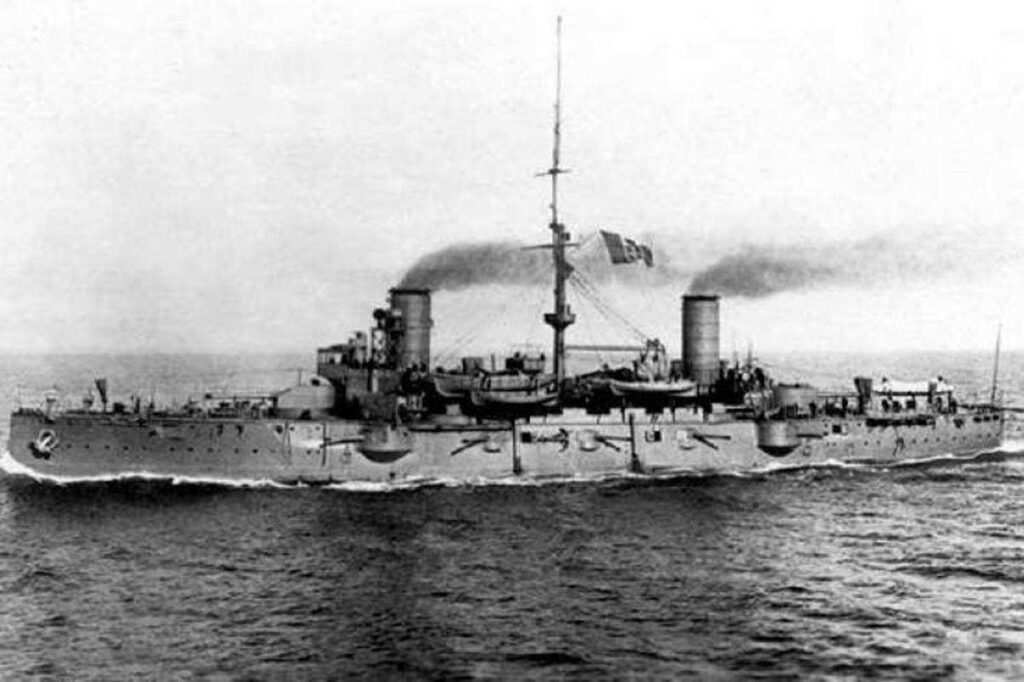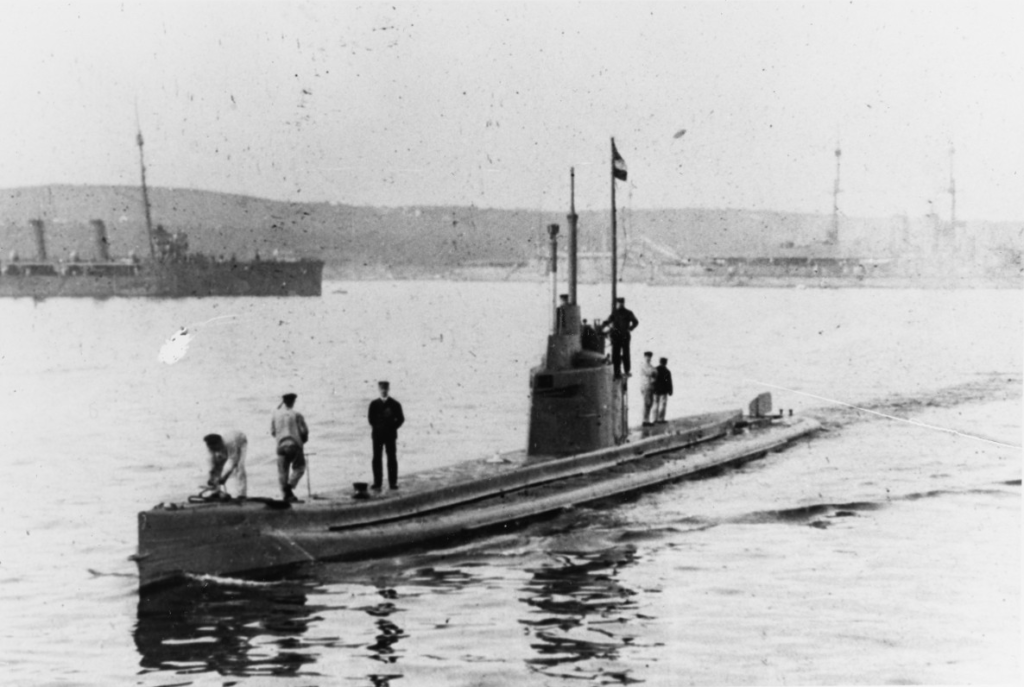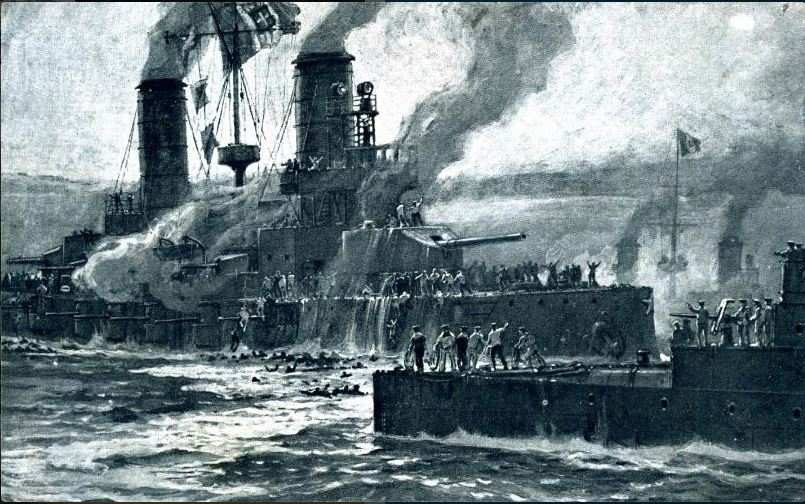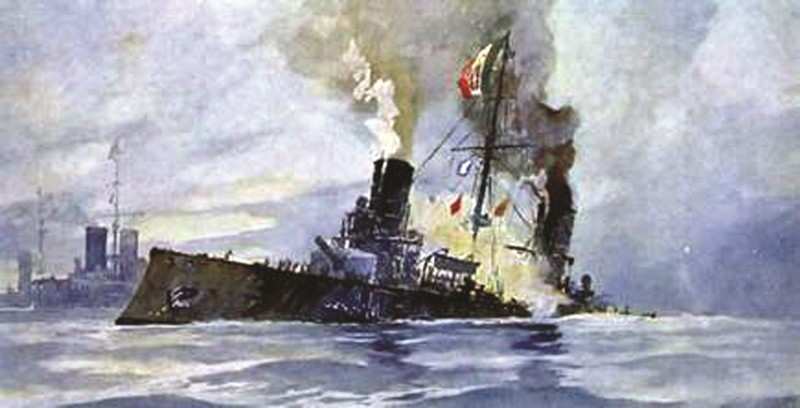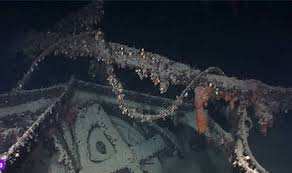Three kilometres (1,8 mi) away from the Konavle Cliffs, at 122 metres (133 yd) of depth, lies a shipwreck of the armoured cruiser Giuseppe Garibaldi. Despite the fact the Konavle residents knew the approximate location of the wreck site, its exact coordinates were determined only in the 21st century; following its discovery, a team of scuba divers launched an expedition in order to perform a detailed exploration and photograph the wreck. Today (17, July 2020) marks the 105th anniversary of the day on which Giuseppe Garibaldi sunk to the depths of the Konavle seabed.
Giuseppe Garibaldi was an armoured cruiser of the Royal Italian Navy (Regia Marina), becoming the flagship of the 5th Squadron in 1915. Its construction began in 1898 and was completed in 1901; an entire ship class was named after it. The overall length of the ship was 111,8 metres (366 ft 10 in) long, while the length of its beam was 18,2 metres (59 ft 9 in); as for its speed, it was capable of reaching 20 knots (37 km/h; 23 mph). It was constructed in the pre-dreadnought era of ship design. Namely, the pre-dreadnought battleships were fitted with a main battery of heavy artillery and one or more secondary batteries consisting of lighter weaponry. The ship’s strongest weapon was a 254-mm (10 in) gun in a turret forward of the superstructure and two 203-millimeter (8 in) guns in a twin turret aft. Four 152-mm (6 in) guns were mounted on the upper deck as secondary armament; 10 more guns of the same calibre were arranged in casemates amidships. The ship also had ten 76-millimeter (3 in) and six 47-millimeter (1.9 in) guns, and was fitted with four underwater 450-millimeter (17.7 in) torpedo tubes. The thickness of the ship’s waterline armour belt was 150 millimeters (5.9 in) amidships and tapered to 80 millimeters (3.1 in) towards the ends of the ship. The conning tower, casemates, and gun turrets were also protected by 150-mm (5.9 in) armour; while the protective deck armour was 37 millimeters (1.5 in) thick. The ship was manned with a complement of 555 officers and sailors, along with 23 additional officers during its tenure as a flagship.
When Italy entered the World War I on the side of the Triple Entente in 1915, the battle for the Adriatic began. In order to disable the harbour in the Bay of Kotor, the second largest port of the Austro-Hungarian Empire, the Italian forces had to destroy the Sarajevo Zelenika railway, which would cut off the port’s supply chain. The railway was first bombarded by the Italians on 5th June; however, the attack failed due to a small number of Italian ships. The second planned attack was initiated on 17th July, when a larger fleet led by four armoured cruisers began the advance towards the Konavle coast. The target of the attack was the railway in the vicinity of the village Mihanići, while a part of the fleet was ordered to attack the island of Šipan and the Gruž harbour in Dubrovnik so as to further weaken the Austro-Hungarian Navy. Nevertheless, the Italian fleet was detected and the nearby U4 submarine was alerted of their presence. Following the unsuccessful Italian bombardment of the railway at 4:37 a.m., the aforementioned Austro-Hungarian submarine was detected by the Italian fleet, which fired several missiles in its direction. The Lieutenant Rudolf Singule, the commander of U4, seized the opportunity and ordered his men to launch two torpedoes at the Italian fleet. Both torpedoes hit Giuseppe Garibaldi,which sank only a few minutes later.
Fifty-three crew members died during the sinking, while the remaining ones were rescued by the nearby torpedo boats. The sinking of Giuseppe Garibaldi marked the end of the Italian Royal Navy’s large ship attacks on the eastern Adriatic coast for the remainder of the World War I. As for Rudolf Singule, the Austro-Hungarian officer was awarded the Knight’s Cross of the Military Order of Maria Theresa for the sinking of the Italian armoured cruiser. The story in question was recorded by the Konavle pastors in their respective parish chronicles, each one offering their own perspective of the event.
The pastor of the Čilipi Parish wrote of the event: Today at 4 o’clock in the morning, the Italian fleet passed by and bombarded Konavle from Zvekovica to Čilipi. The shells were landing above the houses in Uskoplje, in the Valley, in Vojski do, above Gabrili, on the road near Gjuho’s house, close to the railway stop not far from Levata’s house, in Vučje ždrijelo, in the woods near Stevan Simović’s house, about 10 metres (11 yd) above the Miljanovićs’ house below Ivanje brdo in Čilipi. The first one flew above the Miljanovićs’ house; it landed near the children at the Ivanišs’, but luckily no one suffered any grave injuries. One landed in the Gluhan’s barn, where cows and sheep were kept, and did no significant damage. The one that hit the bedrock above Miljanovićs’ blew up the mound, the stone and shrapnel shells were falling all the way to Gjuro Pujo’s and even to Kate Krilanovićs’ house. That lasted until 5 o’clock, and then they turned the guns towards the sea. Below Kolačka glava (the summit of the Mala Suvarovina hill), not far from the shore, our submarine torpedoed the Italian cruiser Giuseppe Garibaldi, which sunk in three minutes. The torpedo boats jumped in to rescue the cruiser’s crew and at half past 5 they all started falling back and hurrying towards Italy. They were firing at the submarine, which hid underwater, until they went out of sight; the submarine then resurfaced and then drove around the battlefield for a bit, and then left. In the afternoon, they found a dead Italian sailor at the edge of the cliffs, and then they dragged him out to the shore. In the sea there were a lot of bodies floating around; they say two of them were women. Various objects were washed ashore, such as the two masts belonging to the sunken ship.
The following was written in the Cavtat Parish chronicle: Sunday: Another attack by the Italian fleet. This morning, a division of the Italian fleet consisting of four armoured cruisers – Vareze, Francisco Feruccio, Giuseppe Garibaldi and Vitottorio Bisani – as well as several torpedo boats, appeared near Cavtat. It opened heavy fire on Uskoplje and the railway in the vicinity of Mihanići, not causing any significant damage in the process. The bombardment, much more severe than the one on 5th June, lasted nearly two hours – from four to six in the morning. Resounding with the intensity of a marching band’s battery section, approximately one thousand shells of various calibres, both larger and smaller, were fired. Simultaneously, the other part of the Italian fleet bombarded Šipan, while the torpedo boats situated on the other side of Daksa and Grebeni fired hundreds of smaller calibre shells on Gruž and Rijeka Dubrovačka with no human casualties nor significant damage. This Italian attack might have lasted longer had the armoured cruiser Giuseppe Garibaldi not sunk below Čilipi, torpedoed by our submarine at precisely 5:45 in the morning. Following the ship’s sinking, the entire Italian fleet, as if burned by fire, immediately started falling back at top speed, only leaving behind a few torpedo boats to rescue the crew of the sunken ship. In the evening of that same day, two sailboats from Cavtat brought various collected objects from the sunken ship to the town port; the recovered objects, found floating in the sea above the ship’s wreckage, were handed over to the local port office. On that same afternoon, the body of one Italian sailor, a stoker by the name of Giacomo Arbace, appeared near the shore. The man was buried at the Sv. Nedjelja graveyard in Čilipi on 22nd July of this year; the following was written on the cross at his burial site: Matrose – Arbace Giacomo von untergangenen Kriegshiff „Garibaldi“.
The pastor from the Stravča Parish, who typically stayed regularly informed of the events on all battlefronts, provided a surprisingly brief and somewhat distorted report on the event: Early in the morning, a part of the Italian squadron of 18 battleships appeared near Cavtat. They fired at the upper parts of the town, as well as the railway from Mihanići to Vojski do. At quarter to four in the afternoon, one of our submarines torpedoed the armoured cruiser Giuseppe Garibaldi, which sunk only fifteen seconds later. The Italian squadron left our shores and ran away after the sinking.
The chronicle of the Mrcine Parish offers only a brief report of the attack: Italian battleships unsuccessfully bombarded the railway stop in Mihanići. A battleship Giuseppe Garibaldi was sunk by one of our submarines.
The pastor of the Pločice Parish noted that the Italian attack captured the attention of his parishioners: The Italians fired at the Cavtat Vojski do railway for the second time. In doing so, they lost a cruiser Giuseppe Garibaldi to one of our submarines; the ship sunk below Popovići (2-3 kilometres (1.2-1.8 miles) away from the shore). The scene was watched by many residents of Poljice, Mikulići and Molunat.
